Journal of the NACAA
ISSN 2158-9429
Volume 10, Issue 2 - December, 2017
Establishing Cooperative Extension Directions for Arizona Beef Producer Programs
- Wright, A. D., Livestock Area Agent, The University Of Arizona Cooperative Extension
Greene, E. A., Equine Extension Specialist, University of Arizona, School of Animal and Comparative Biomedical Sciences
Faulkner, D. B., Beef Extension Specialist, University of Arizona, School of Animal and Comparative Biomedical Sciences
ABSTRACT
To identify perceived needs for developing extension programming for the ranching industry in Arizona, a statewide survey was created and distributed to Arizona beef producers through several avenues. Respondents rated perceived level of need for education on 46 topics. Beef producers were most concerned with animal health and land and resource stewardship, as well as improving the profitability and sustainability of their operations by reducing costs, increasing the number and weight of calves sold, and increasing the value of their calves. The data obtained from this survey is being used to guide Arizona beef producer extension program development and delivery.
Introduction
Nationally, the United States is the largest producer of beef in the world, and sales of cattle and calves account for 19.4% of all agricultural sales nationwide. Arizona’s beef industry follows the same trend with approximately 300,000 head of beef cattle on 4,800 farms in the state (USDA, 2014). The beef ranching sector contributes an estimated $814 million in sales to the Arizona economy, with the total estimated output of the beef industry at $1.2 billion (Kerna et al., 2014). Most cow-calf operations (ranches) in the state are utilizing a significant portion of state or public land (BLM or Forest Service) for grazing. Nearly all of the ranching operations are family owned and operated, with a few employing full or part time help (Teegerstrom and Tronstad, 2014).
University of Arizona Cooperative Extension delivers research based information to livestock producers, especially ranchers across the state. These programs cover topics such as livestock health and management, beef quality assurance (BQA), range health and management, estate planning, record keeping, and risk management tools. With new personnel in several key livestock and equine extension positions and extremely dated (2002) information regarding Arizona livestock stakeholder needs, an updated survey covering all livestock species was developed with input from pertinent extension specialists. The 2016 survey included general questions, demographics, and sections for beef, equine, dairy, and “other” livestock species. The use of Qualtrics (Qualtrics, 2016) software allowed economically viable widespread distribution of the entire survey. A key factor to streamline the participant experience was that respondents were only presented with questions related to the species that they selected. Survey results were sorted and distributed to the appropriate faculty members to use in their programmatic decision-making. Printed copies of the survey were easily created from the Qualtrics software to those stakeholders who preferred a paper copy, many of whom were ranchers.
Materials and Methods
Qualtrics® (Qualtrics, 2016) was used to create an updated survey based on an Arizona Cooperative Extension livestock stakeholder survey last completed in 2002. The survey was composed of three sections:
- General questions regarding location, type of land used (private, state, federal, or tribal), preferred methods of extension program delivery, where respondents currently received their livestock information, and the species the producer raised (beef, dairy, equine, and/or other livestock),
- Species specific sections where respondents only received questions for the specie(s) they had selected from section one, and
- Demographics asking respondents to provide their age (range), gender, and ethnicity.
The survey was available from December 2015 through May 2016. It was distributed to livestock and equine producers through Cooperative Extension and other industry mailing/email lists, webpages, personal contacts, and through Facebook/Social Media avenues. The Arizona Cattlelog, the monthly publication of the Arizona Cattle Growers’ Association, also printed the survey information in their December 2015 issue (Wright, 2015). Paper surveys were made available at some beef related Cooperative Extension events and mailed to rancher mailing lists during the collection period. Beef results were separated from the larger pool of respondents for analysis. This survey was deemed program evaluation, and therefore exempted by the University of Arizona Institutional Review Board.
Respondents who indicated they raised beef cattle received sections 1 and 3 of the survey, as well as a beef specific section 2. This beef specific section asked respondents if they had ever attended a beef program sponsored by the University of Arizona Cooperative Extension, what the most recent program attended was, and if they were Beef Quality Assurance (BQA) certified. Survey takers were then presented with 46 beef and ranching related topics and were asked to rate the perceived need of each topic as “no need”, “slight need”, “moderate need”, or “critical need”. Topics fell under the broad headings of Ranch Business Planning, Herd Health and Reproduction, Programs and Regulations, and Rangeland Health and Management.
Results & Discussion
A total of 141 beef producers from across the state responded to the survey. Due to the wide variety of distribution methods, the total number of surveys distributed is unknown. Responders provided their zip code but no other identifying information was collected.
Demographics. Respondents to the survey were 50:50 male:female, a much higher ratio of women than expected. The 2012 Census of Agriculture for Arizona (USDA, 2014) indicates approximately 1,300 beef cattle ranches and farms with a principle woman operator (27%). It is likely that our survey may have been completed by a spouse, who may also be a significant contributor to the operation, but is not necessarily who the Census of Agriculture determined to be the “principle operator”. The age of the survey respondents (Figure 1) followed national trends of an aging agricultural population, with 35% and 45% of respondents falling into the 30-49 and 50-69 age ranges, respectively. Another 13% were seventy years of age or older leaving only 6% of respondents less than 30 years of age. Eighty percent of respondents identified as white (non-Hispanic), 12% as Native American, 4% Hispanic, and 4% other. This differs significantly from Arizona’s general population where approximately 55% and 30% identify as white (non-Hispanic) and Hispanic, respectively (Arizona Office of Economic Security, 2010).
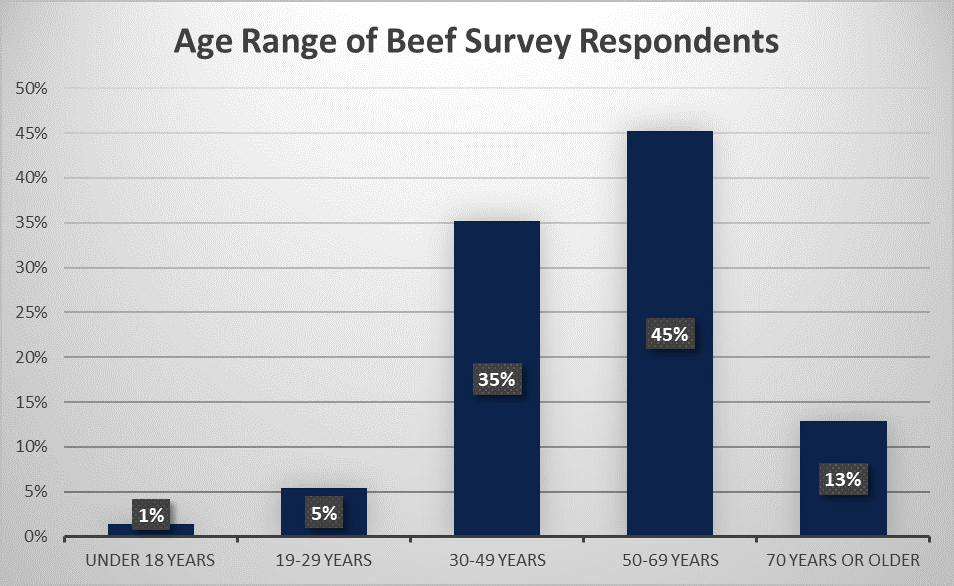
Figure 1. Reported age ranges of beef survey respondents follows national trends of an aging agricultural population.
Land Use. The state of Arizona is comprised of 17.7% private land, 42% federal (BLM and Forest), 12.8% state, and 27.2% tribal land, however, land composition varies considerably by county. For example, Cochise County boasts 39% private land, while Gila County only has 4% private ground. Even Maricopa County, which encompasses the Phoenix metro area, is composed of only 29% private land (Arizona Land Composition, 2016). Often ranches operate on more than one type of land and most have at least a small piece of private land adjoining their public or state land permit. A few operations lease larger pieces of private ground. Private land was utilized by 89% of survey respondents. Federal (BLM or Forest Service) was used by 35%, state land by 34%, and 9% of respondents utilized tribal land for their operations. Land type can affect a rancher’s ability to alter grazing rotation, herd size, and supplement usage as well as affect ranch improvement projects such as water development.
Beef Quality Assurance. Fifty-seven percent of respondents were Arizona Beef Quality Assurance (BQA) certified. BQA is a national certification program that emphasizes producer commitments to best management practices. These practices encompass low-stress livestock handling, proper record keeping, herd health and vaccinations, and food safety and quality with the goal of increasing consumer confidence in the beef industry. A producer who completes the BQA certification is likely to adopt some or all of the suggested BQA practices, thus increasing the quality and safety of the beef produced by that operation. Over half of respondents ranked the Arizona BQA program as a topic with moderate to critical need.
Current Information Resources. When asked about their top three current preferred resources for livestock information (Figure 2), most producers indicated that they reached out to other ranchers or utilized publications and magazines (e.g. BEEF Magazine and the Arizona Cattlelog). Forty five percent of producers reported utilizing their veterinarians or Arizona Cooperative Extension as a resource. The results for Arizona Cooperative Extension may be inflated, as this survey was distributed to existing Cooperative Extension lists and contacts.
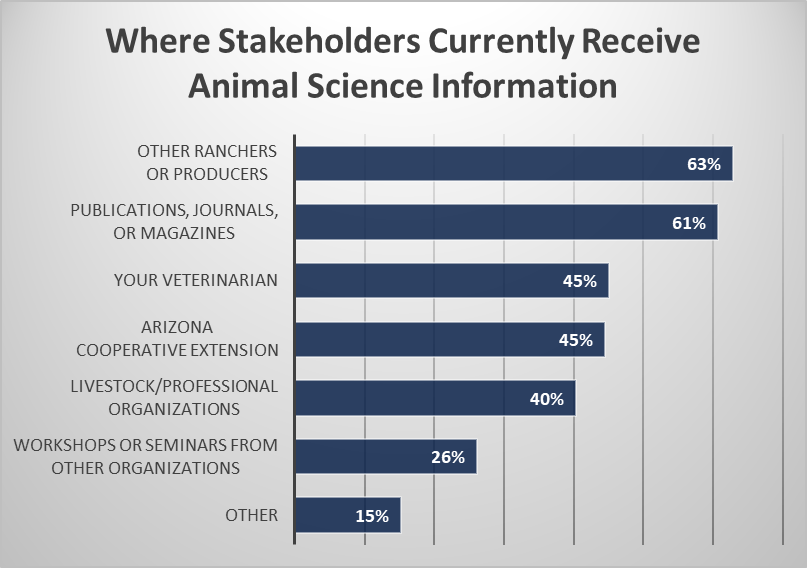
Figure 2. Respondents were asked to identify their top three resources used to gather information OR gain knowledge.
Interestingly, while almost half of beef respondents used Cooperative Extension as a resource (Figure 3), 31% percent of them had not attended an extension beef event in the past year, and 50% had never attended one. This may be explained in part, by a lack of continuity in some key livestock/equine positions over the last several years. With several new livestock Arizona Cooperative Extension agents and specialists hired in the last few years, there are now more educational opportunities available. Producers who had attended an event had participated in range monitoring workshops, the Range Livestock Nutrition workshop (a yearly event), or Beef Quality Assurance trainings. Maintaining continuity in both agent and specialist positions and understanding the current needs of our stakeholders is critical for developing programming that will engage Arizona producers and fulfill our mission as a land grant institution.
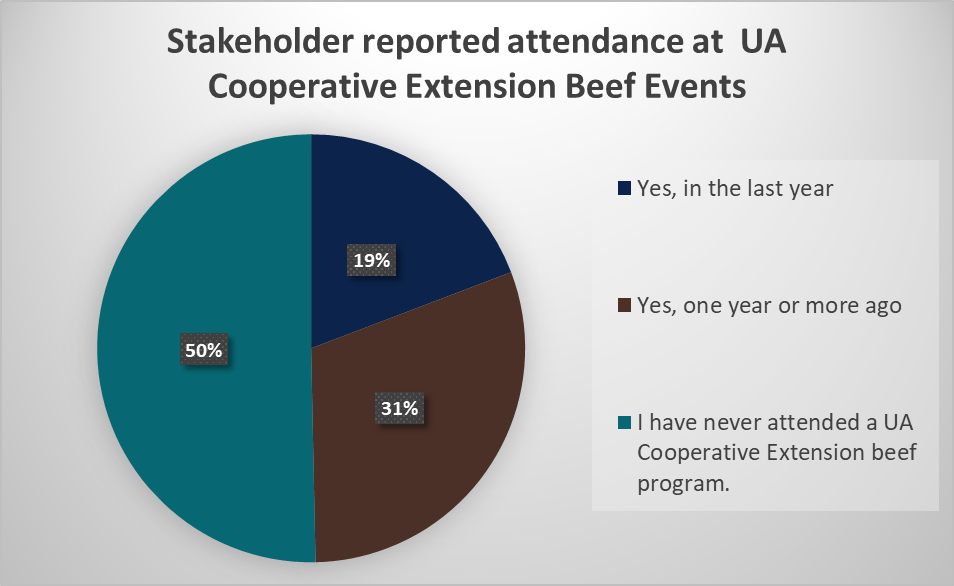
Figure 3. Half of respondents had never attended a UA Cooperative Extension beef program.
Program Delivery. Respondents were asked to indicate their top three preferred methods of program delivery (Figure 4). The most preferred methods were workshops, hands-on field days, and newsletters. Based on the median age of respondents, it is not surprising that social media was one of the lower ranked program delivery options within the ranching community. Other species results, particularly equine, had a much higher request for program delivery via social media. While fact sheets did not rank highly, they are important to the Cooperative Extension model of providing actionable, science based information on topics of value to stakeholders. While producers may not actively seek out factsheets as a stand-alone piece of information, these are often incorporated into educational events (e.g. workshops and seminars) as supplemental material addressing topics in a nonbiased manner.
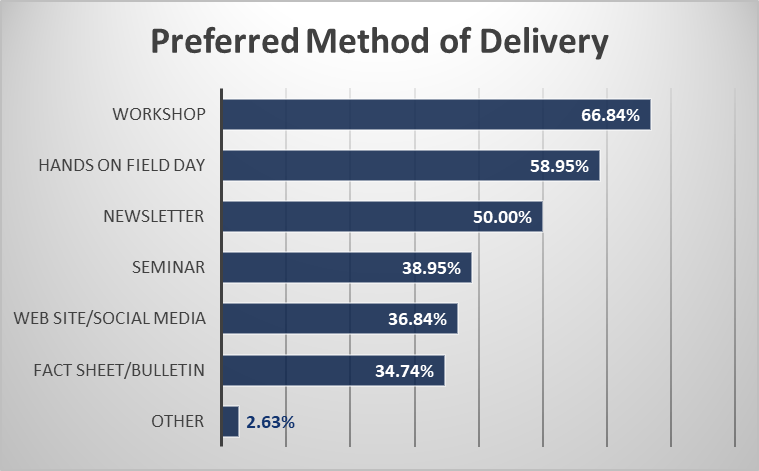
Figure 4. Respondents were asked to select their top three preferred methods of program delivery.
These survey results are already being implemented into Cooperative Extension programming, as demonstrated by an increase in workshops which include “hands-on” aspects and demonstrations whenever possible, as well as the creation of the quarterly Southeastern Arizona Range and Livestock Newsletter. This newsletter began as the collaboration of three faculty members (from livestock, range management, and climatology) and was distributed throughout the southeast portion of Arizona. In 2017, it has expanded to include two additional county agents and four specialists, and now reaches cattle producers statewide.
Topics of Need. The beef specific section of the survey asked respondents to rank 46 beef related topics by perceived level of need (no need, slight need, moderate need, or critical need) for education. Topics fell under the broad categories of ranch business planning, herd health and reproduction, programs and regulations, and rangeland health and management.
Ranch Business Planning. The majority of the ranch business management topics were assigned moderate need by more than half of respondents (Figure 5). These topics are often identified as important, but not necessarily critical. As a result, these topics will be worked into educational programs as secondary topics rather than “headliners’, since they may not draw the ranchers to the event.
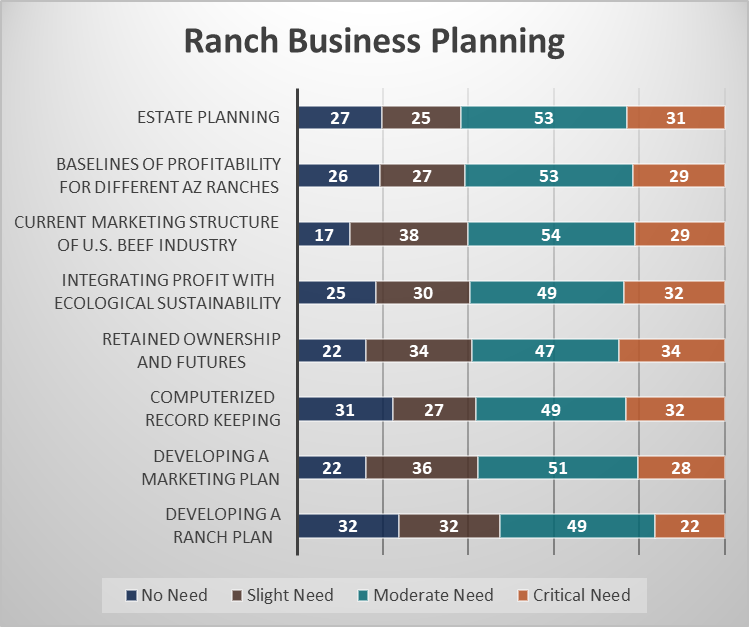
Figure 5: Producer rankings of ranch business planning topics by no need, slight need, moderate need, or critical need.
Herd Health and Reproduction. Four topics were highly ranked, identified as moderate to critical need by more than two-thirds of respondents: emerging diseases for Arizona, emergency veterinary skills for ranchers, range cow nutrition, and preconditioning programs (Figure 6). Only two leaned heavily towards no to slight need: estrus synchronization and artificial insemination. These two topics are not often utilized in Arizona due to the challenges associated with ranching on large area of public land. Additionally, many ranches are unequipped to deal with the challenges of such intensive breeding practices.
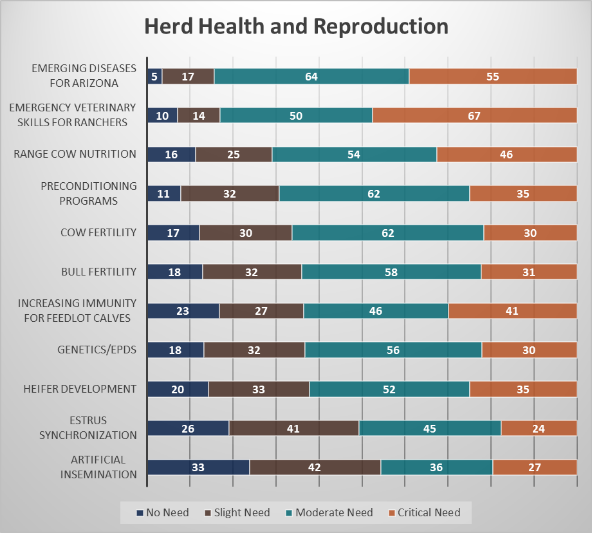
Figure 6. Producer rankings of Herd Health and Reproduction topics by no need, slight need, moderate need, and critical need.
Programs and Regulations. Producers indicated a moderate need for education on the new Veterinary Feed Directive rules which took effect January 1, 2017 (Figure 7). This survey was conducted in early 2016, and there had been a significant amount of misinformation regarding what medications would and would not be available over the counter when the directive took effect. Animal behavior and facilities design, animal handling and transportation, and process verified programs were not as well regarded in the survey, however these topics are included in the Arizona Beef Quality Assurance program, which was ranked highly, despite only 57% of producers reporting certification. This program may represent a way to engage producers on some of the more moderately rated but important topics.
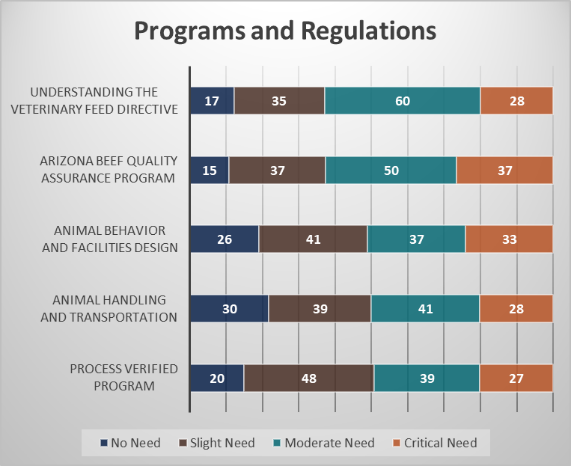
Figure 7: Producer rankings of Programs and Regulation topics by no need, slight need, moderate need, and critical need.
Rangeland Heath and Management. This topic area included many questions relevant to rangeland health and natural resource programming (Figure 8). Those results have been shared with relevant faculty, and only those topics that crossover significantly into livestock programming have been included here. Range plant nutrition and grazing quality was highly rated and closely related to the range cow nutrition topic included in the herd health and reproduction category. Not surprisingly, knowledge on toxic plants was also considered an area of need. Cattle on rangelands are frequently in contact with toxic plants and unexplained deaths are often traced back to plant toxicity. Despite the current, controversial Mexican Grey Wolf Reintroduction program in affecting portions of Arizona and New Mexico, the topic of livestock-wildlife interactions did not rank especially highly. This could be, in part, due to the contentious nature of this issue. Ranchers are often not in favor of introducing predators which can negatively impact their cow calf operations, especially given the expansive amount of land necessary to raise those cattle.
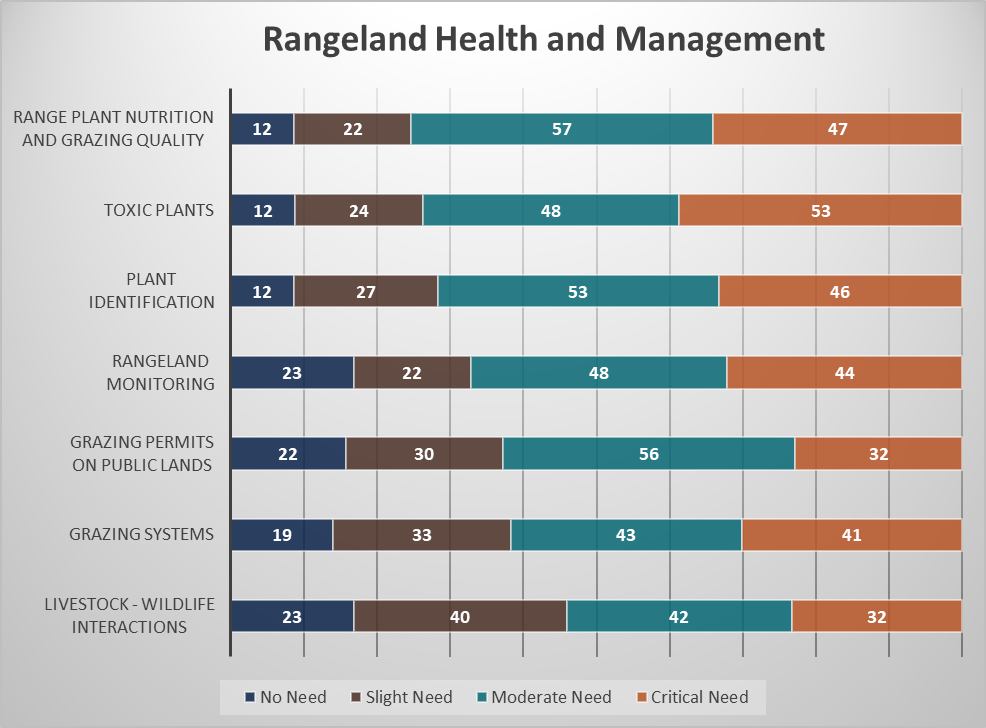
Figure 8. Producer rankings of Rangeland Health and Management topics by no need, slight need, moderate need, and critical need.
Conclusions
Arizona beef stakeholders have a wide variety of needs including livestock health and management, range and natural resource management, understanding policy and law, and economic concerns. Addressing all of these needs will require strong collaboration among extension specialty areas (livestock, range management, economics, and climate). Additionally, 64% of beef producers also indicated that they had horses, representing an important crossover opportunity in beef and equine education. The needs of the working equine community may be addressed by including relevant horse topics at beef focused events. This was done at the UA Cattlemen’s College in Tucson, AZ (May 2016), a Graham County Rancher Roundtable Event (November 2016), and the 2017 Range Livestock Nutrition Workshop (March 2017).
Results of this survey have been used to guide the development of new and existing extension programs aimed at beef producers. Workshop series addressing producer-identified topics of need have been held or planned in multiple counties to include beef, range, and equine faculty. Other established workshops, such as Graham County’s Farm Home and Ranch Day, have moved to a more hands-on demonstration format than in previous years. The 2016 Farm Home and Ranch Day drew 35 beef producers, up from only a few participants in the years prior. In addition to the newsletter mentioned above, several agents and specialists have collaborated on peer reviewed extension publications to address identified needs. These publications are disseminated online and handed out as educational materials at extension beef events.
While the survey indicated that 45% of producers utilize Arizona Cooperative Extension as a resource for information, there is still work to be done to improve the impact of Cooperative Extension on beef producers. This number is likely inflated, as many of those who took the survey had probably already interacted with Arizona Cooperative Extension and looked to them for information. Regardless, this survey data makes it possible for new agents to reach stakeholders with information that directly addresses producer priorities and results in positive impacts on beef extension programming throughout the state.
The format used to deliver this survey (Qualtrics) may be useful to other states looking to gather similar data. It allows the survey to reach a very broad audience (beef, dairy, equine, and other livestock), yet it only presents them with questions that are specific to their operations. The information gathered is valuable and easily shared with specialists, agents, and program coordinators across the state who work with livestock producers. Additionally, this data can represent a baseline from which to measure programmatic effectiveness over time. Qualtrics software is user-friendly and data can be manipulated within the software or downloaded directly into Excel for easy analysis. Two challenges to consider include the availability of internet in some geographic regions, and the willingness of the audience to utilize technology.
References
Arizona Land Composition. (2016). Counter Supervisors Association of Arizona Website. Retrieved from: http://www.countysupervisors.org/wp-content/uploads/2014/09/AZ-Land-Composition.pdf
Arizona Office of Economic Opportunity. (2010). Census Data: Census 2010 & Census 2000 Demographics for Arizona. Phoenix, AZ. Retrieved from: https://population.az.gov/census-data
Kerna, A., Frisvold, G., Tronstad, R., & Teegerstrom, T. (2014). The Contribution of the Beef Industry to the Arizona Economy. University of Arizona Cooperative Extension. Retrieved from: https://cals.arizona.edu/arec/sites/cals.arizona.edu.arec/files/publications/contrib_beef_industry_to_az_econ_complete.pdf
Qualtrics. ( 2016). Provo, UT, USA; Qualtrics. Retrieved from: http://www.qualtrics.com
Teegerstrom, T., & Tronstad, R. (2017). Arizona Ranching Budgets: 2016 (az1734). University of Arizona Cooperative Extension. Retrieved from: https://extension.arizona.edu/sites/extension.arizona.edu/files/pubs/az1734-2017.pdf
United States Department of Agriculture, National Agriculture Statistics Service. (2014). 2012 Census of Agriculture: Arizona State and County Data (Vol. 1, Geographic Area Series, pp. 19-21). Retrieved from: https://www.agcensus.usda.gov/Publications/2012/Full_Report/Volume_1,_Chapter_1_State_Level/Arizona/azv1.pdf
Wright, A. D. (2015). Announcing the 2015 Statewide Livestock Survey. Arizona Cattlelog: Official Publication of the Arizona Cattle Growers' Association, 70(4), p19.
